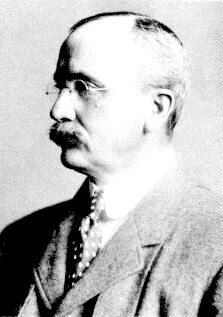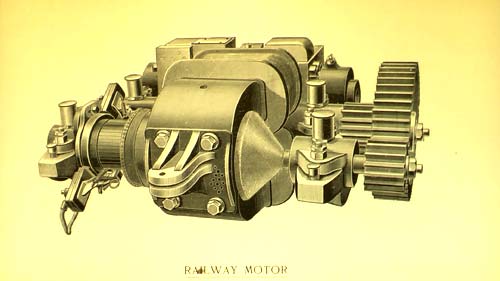William Leroy Emmet
Pioneer of the electric drive in ships, steam turbines, electric motors and countless other improvements in AC power.
William LeRoy Emmet (1859-1941) consulting engineer of the General Electric Company, devoted years to the study of electric ship propulsion and was recognized as a pioneer in this line of work. As early as 1909 he pointed out that electric ship propulsion was feasible, economical, and practical. He also gained fame with his development of the steam turbine and the Emmet mercury vapor process of power generation. He held an impressive 122 patents during his lifetime.
Biography

|
|
Emmet helped design generators for the famous Niagara Falls hydropower project. This solidified respect for his expertise in the corporate world and allowed him to take on the steam turbine as the next project.

Above: a railway electric motor from Thomson-Houston Company. 1880s.
In 1901 he took up the study of the Curtis steam turbine. He began experimenting upon
arrangements different from those which Mr. Curtis had tried and, in a very short time,
developed a large and successful industry which far outstripped all other turbine
activities in the electrical field.
See our video where historian George Wise talks about Emmet's role in pioneering the steam turbine.
The next large campaign to which Mr. Emmet devoted his energies was the development of electrical propulsion in ships. Through his efforts the electric drive for large warships was adopted by the Navy, the first of these being installed in the USS New Mexico.
it was in the midst of his ship activities that Mr. Emmet began work on the development of a process embodying the vaporizing of mercury instead of water in turbines for the generation of power. The vaporized mercury, after driving one turbine, is condensed, and in cooling it water is converted into steam to drive a second turbine from the one firebox. The first plants of this type were installed at Hartford, Connecticut, Schenectady, New York, Kearney, New Jersey, Lynn and Pittsfield, Massachusetts.
Prior to his achievements in the steam turbine field~ he attained prominence through his
work in developing the general use of alternating current,
and a number of inventions
which since have come into universal use stand to his credit. Among his more important
electrical inventions are the oil switch
and varnished cambric cable. He also invented
several types of transformers, several different forms of insulation for alternators,
and many devices that are employed in connection with the Curtis steam turbine. His most
brilliant accomplishments, however, were more in the nature of an institutor of new
methods and ideas than as an inventor, and a great deal of his most useful work could
not be patented nor even classified as invention. His qualifications, specially fitted
him for finding new scope for the talent and facilities of the Company's organization.
Emmet was a pleasant natured bachelor who enjoyed hobbies like swimming, curling, skiing, fishing and
astronomy.
Mr. Emmet was the author of "The Autobiography of an Engineer", "Alternating Current Wiring and Distribution", and of numerous important papers presented before the American Institute of Electrical Engineers and other engineering societies. He was a member of the American Philosophical Society, American Institute of Electrical Engineers, American Society of Mechanical Engineers, Society of Naval Architects and Marine Engineers, and of the wartime Naval Consulting Board of the United States. He received the honorary degree of D.Sc. from Union College in 1910, and later the same degree from Trinity College. He was awarded the Gold Medal for vertical shaft turbines at the St. Louis Exposition, the Gold Medal for electric ship propulsion at the San Francisco Exposition, and the Elliott Cresson Medal in 1920. William Emmet died September 26, 1941, at the age of eighty-two.
Edison Tech Center
General Electric
Sources:
Edwin Reilly Jr.
The General Electric Story. by Bernard Gorowitz. 1999
If you are a historian and wish to correct facts or publish a commentary or embedded article feel free to contact us.
Photos:: Permission and fees are required for use of photos in printed or internet publications.
Educational Use:: Students and teachers may use photos and videos at school. Graphics and photos must retain the Edison Tech Center watermark or captions and remain unmanipulated except for sizing.
Videos:: DVDs are available for personal/educational use. Republication of any part or whole of any ETC video requires a professional license agreement. Contact us for legal permissions and fees.

